LINCOLN MKZ 2014 Owners Manual
Manufacturer: LINCOLN, Model Year: 2014, Model line: MKZ, Model: LINCOLN MKZ 2014Pages: 468, PDF Size: 4.49 MB
Page 291 of 468
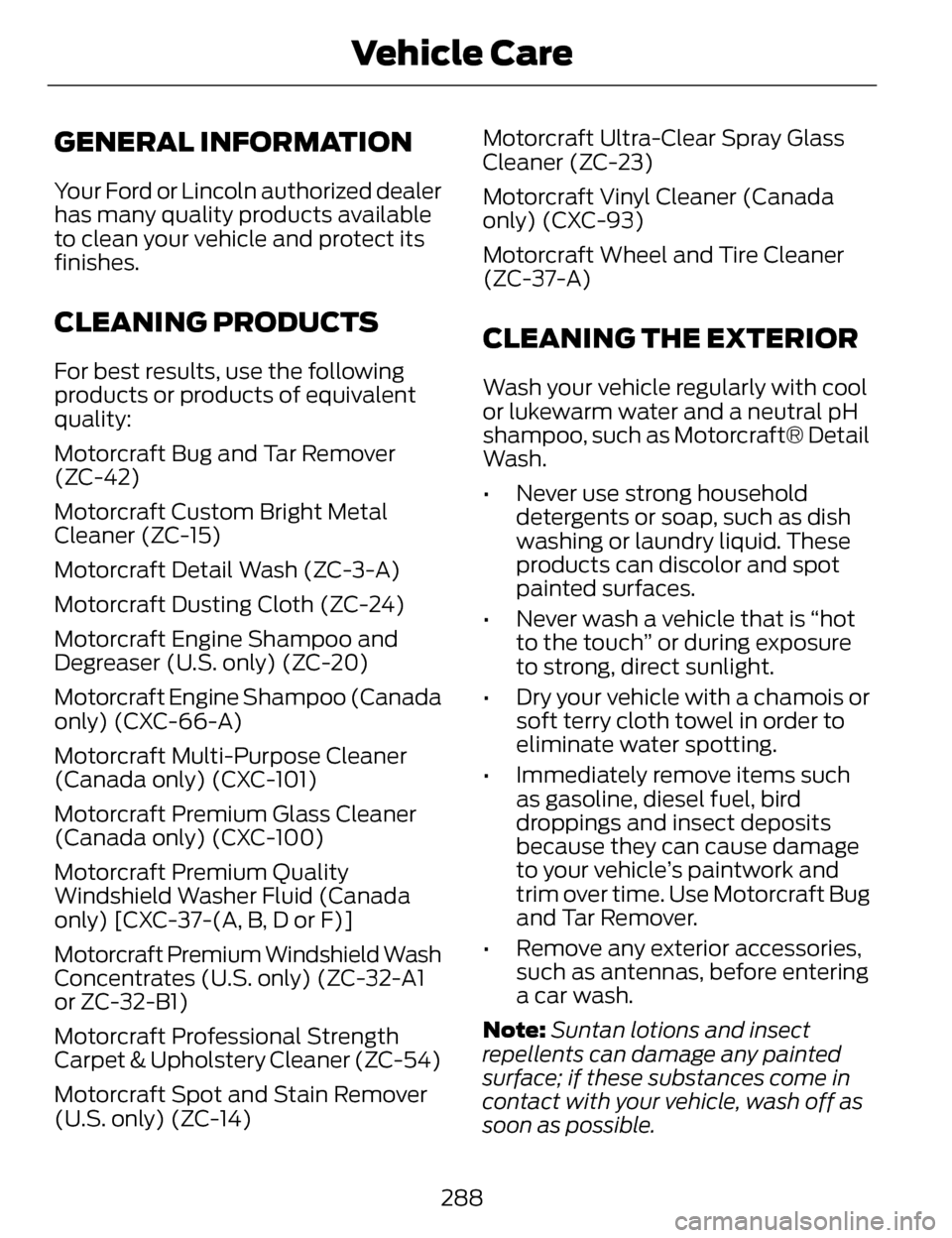
GENERAL INFORMATION
Your Ford or Lincoln authorized dealer
has many quality products available
to clean your vehicle and protect its
finishes.
CLEANING PRODUCTS
For best results, use the following
products or products of equivalent
quality:
Motorcraft Bug and Tar Remover
(ZC-42)
Motorcraft Custom Bright Metal
Cleaner (ZC-15)
Motorcraft Detail Wash (ZC-3-A)
Motorcraft Dusting Cloth (ZC-24)
Motorcraft Engine Shampoo and
Degreaser (U.S. only) (ZC-20)
Motorcraft Engine Shampoo (Canada
only) (CXC-66-A)
Motorcraft Multi-Purpose Cleaner
(Canada only) (CXC-101)
Motorcraft Premium Glass Cleaner
(Canada only) (CXC-100)
Motorcraft Premium Quality
Windshield Washer Fluid (Canada
only) [CXC-37-(A, B, D or F)]
Motorcraft Premium Windshield Wash
Concentrates (U.S. only) (ZC-32-A1
or ZC-32-B1)
Motorcraft Professional Strength
Carpet & Upholstery Cleaner (ZC-54)
Motorcraft Spot and Stain Remover
(U.S. only) (ZC-14)Motorcraft Ultra-Clear Spray Glass
Cleaner (ZC-23)
Motorcraft Vinyl Cleaner (Canada
only) (CXC-93)
Motorcraft Wheel and Tire Cleaner
(ZC-37-A)
CLEANING THE EXTERIOR
Wash your vehicle regularly with cool
or lukewarm water and a neutral pH
shampoo, such as Motorcraft® Detail
Wash.
• Never use strong household
detergents or soap, such as dish
washing or laundry liquid. These
products can discolor and spot
painted surfaces.
• Never wash a vehicle that is “hot to the touch” or during exposure
to strong, direct sunlight.
• Dry your vehicle with a chamois or soft terry cloth towel in order to
eliminate water spotting.
• Immediately remove items such as gasoline, diesel fuel, bird
droppings and insect deposits
because they can cause damage
to your vehicle’s paintwork and
trim over time. Use Motorcraft Bug
and Tar Remover.
• Remove any exterior accessories, such as antennas, before entering
a car wash.
Note: Suntan lotions and insect
repellents can damage any painted
surface; if these substances come in
contact with your vehicle, wash off as
soon as possible.
288
Vehicle Care
Page 292 of 468
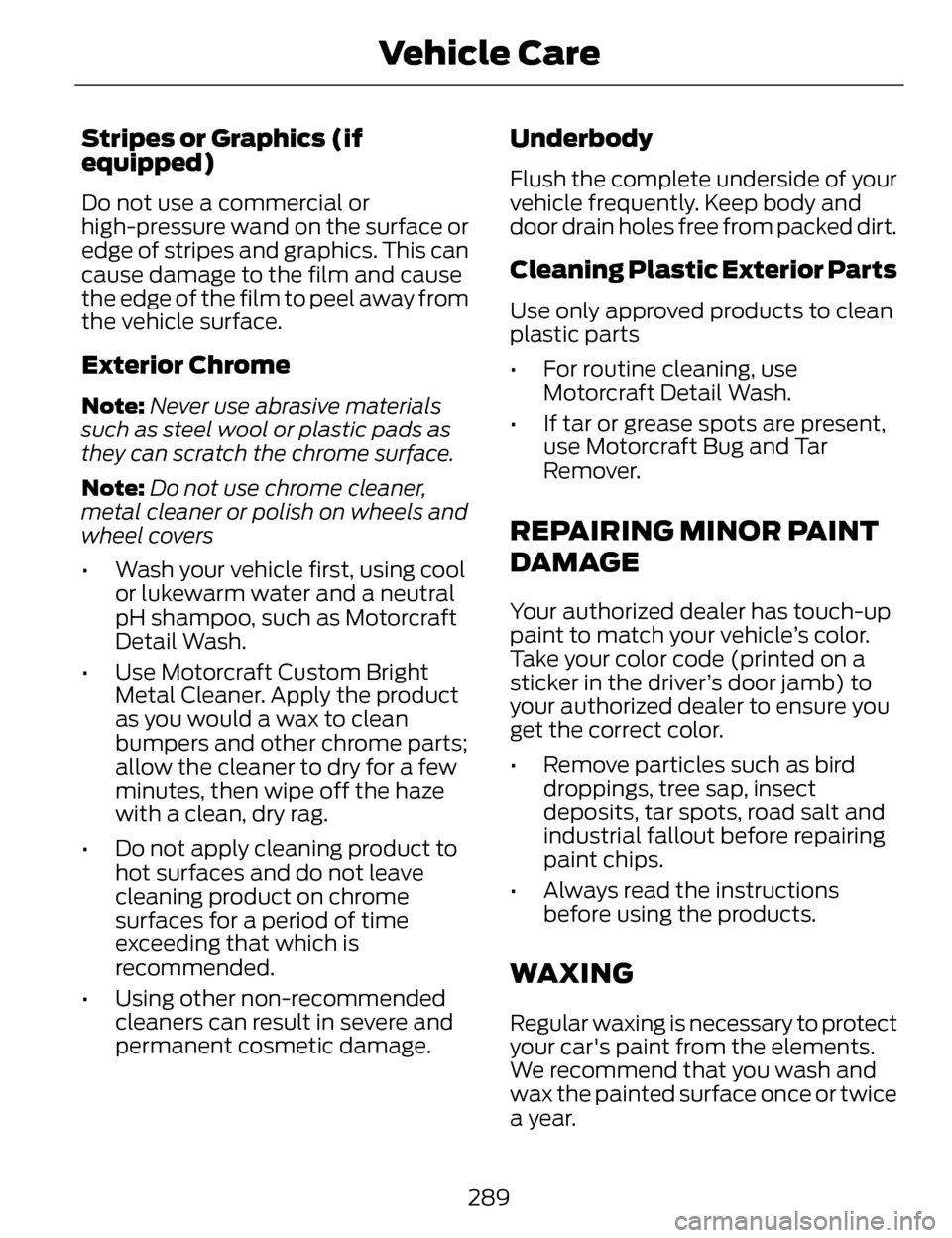
Stripes or Graphics (if
equipped)
Do not use a commercial or
high-pressure wand on the surface or
edge of stripes and graphics. This can
cause damage to the film and cause
the edge of the film to peel away from
the vehicle surface.
Exterior Chrome
Note:Never use abrasive materials
such as steel wool or plastic pads as
they can scratch the chrome surface.
Note: Do not use chrome cleaner,
metal cleaner or polish on wheels and
wheel covers
• Wash your vehicle first, using cool or lukewarm water and a neutral
pH shampoo, such as Motorcraft
Detail Wash.
• Use Motorcraft Custom Bright Metal Cleaner. Apply the product
as you would a wax to clean
bumpers and other chrome parts;
allow the cleaner to dry for a few
minutes, then wipe off the haze
with a clean, dry rag.
• Do not apply cleaning product to hot surfaces and do not leave
cleaning product on chrome
surfaces for a period of time
exceeding that which is
recommended.
• Using other non-recommended cleaners can result in severe and
permanent cosmetic damage.
Underbody
Flush the complete underside of your
vehicle frequently. Keep body and
door drain holes free from packed dirt.
Cleaning Plastic Exterior Parts
Use only approved products to clean
plastic parts
• For routine cleaning, useMotorcraft Detail Wash.
• If tar or grease spots are present, use Motorcraft Bug and Tar
Remover.
REPAIRING MINOR PAINT
DAMAGE
Your authorized dealer has touch-up
paint to match your vehicle’s color.
Take your color code (printed on a
sticker in the driver’s door jamb) to
your authorized dealer to ensure you
get the correct color.
• Remove particles such as birddroppings, tree sap, insect
deposits, tar spots, road salt and
industrial fallout before repairing
paint chips.
• Always read the instructions before using the products.
WAXING
Regular waxing is necessary to protect
your car's paint from the elements.
We recommend that you wash and
wax the painted surface once or twice
a year.
289
Vehicle Care
Page 293 of 468
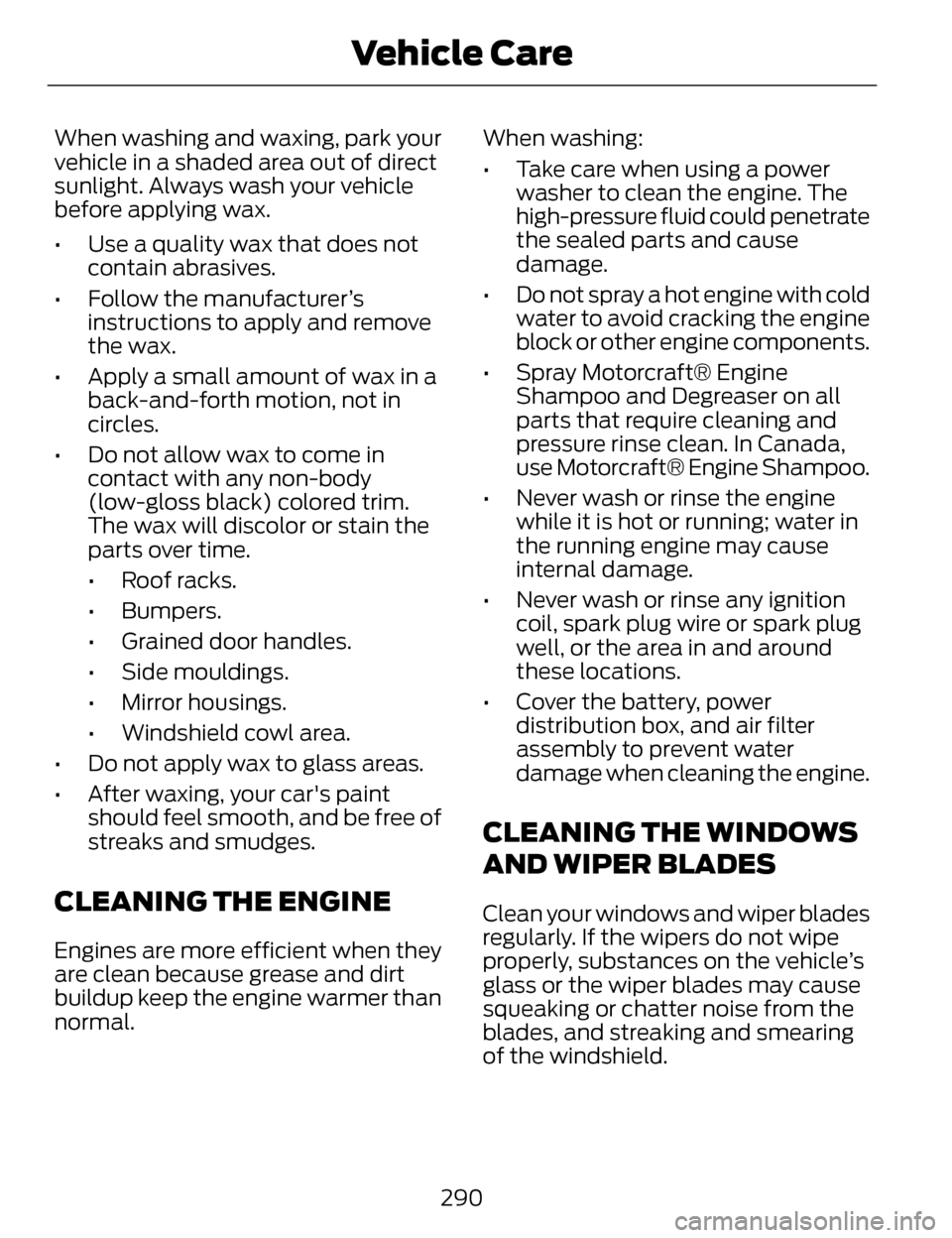
When washing and waxing, park your
vehicle in a shaded area out of direct
sunlight. Always wash your vehicle
before applying wax.
• Use a quality wax that does notcontain abrasives.
• Follow the manufacturer’s instructions to apply and remove
the wax.
• Apply a small amount of wax in a back-and-forth motion, not in
circles.
• Do not allow wax to come in contact with any non-body
(low-gloss black) colored trim.
The wax will discolor or stain the
parts over time.
• Roof racks.
• Bumpers.
• Grained door handles.
• Side mouldings.
• Mirror housings.
• Windshield cowl area.
• Do not apply wax to glass areas.
• After waxing, your car's paint should feel smooth, and be free of
streaks and smudges.
CLEANING THE ENGINE
Engines are more efficient when they
are clean because grease and dirt
buildup keep the engine warmer than
normal. When washing:
• Take care when using a power
washer to clean the engine. The
high-pressure fluid could penetrate
the sealed parts and cause
damage.
• Do not spray a hot engine with cold water to avoid cracking the engine
block or other engine components.
• Spray Motorcraft® Engine Shampoo and Degreaser on all
parts that require cleaning and
pressure rinse clean. In Canada,
use Motorcraft® Engine Shampoo.
• Never wash or rinse the engine while it is hot or running; water in
the running engine may cause
internal damage.
• Never wash or rinse any ignition coil, spark plug wire or spark plug
well, or the area in and around
these locations.
• Cover the battery, power distribution box, and air filter
assembly to prevent water
damage when cleaning the engine.
CLEANING THE WINDOWS
AND WIPER BLADES
Clean your windows and wiper blades
regularly. If the wipers do not wipe
properly, substances on the vehicle’s
glass or the wiper blades may cause
squeaking or chatter noise from the
blades, and streaking and smearing
of the windshield.
290
Vehicle Care
Page 294 of 468
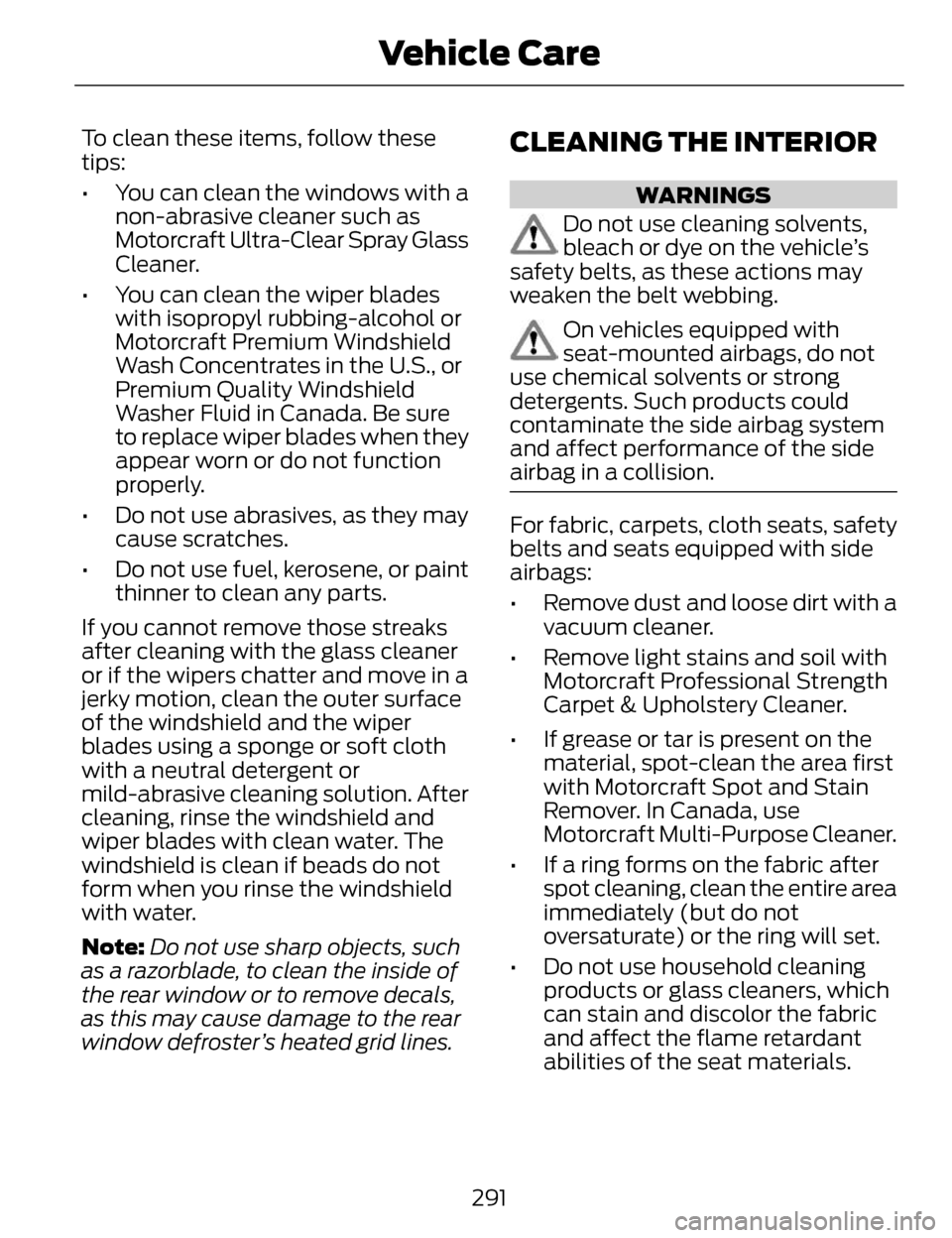
To clean these items, follow these
tips:
• You can clean the windows with anon-abrasive cleaner such as
Motorcraft Ultra-Clear Spray Glass
Cleaner.
• You can clean the wiper blades with isopropyl rubbing-alcohol or
Motorcraft Premium Windshield
Wash Concentrates in the U.S., or
Premium Quality Windshield
Washer Fluid in Canada. Be sure
to replace wiper blades when they
appear worn or do not function
properly.
• Do not use abrasives, as they may cause scratches.
• Do not use fuel, kerosene, or paint thinner to clean any parts.
If you cannot remove those streaks
after cleaning with the glass cleaner
or if the wipers chatter and move in a
jerky motion, clean the outer surface
of the windshield and the wiper
blades using a sponge or soft cloth
with a neutral detergent or
mild-abrasive cleaning solution. After
cleaning, rinse the windshield and
wiper blades with clean water. The
windshield is clean if beads do not
form when you rinse the windshield
with water.
Note: Do not use sharp objects, such
as a razorblade, to clean the inside of
the rear window or to remove decals,
as this may cause damage to the rear
window defroster’s heated grid lines.CLEANING THE INTERIOR
WARNINGS
Do not use cleaning solvents,
bleach or dye on the vehicle’s
safety belts, as these actions may
weaken the belt webbing.
On vehicles equipped with
seat-mounted airbags, do not
use chemical solvents or strong
detergents. Such products could
contaminate the side airbag system
and affect performance of the side
airbag in a collision.
For fabric, carpets, cloth seats, safety
belts and seats equipped with side
airbags:
• Remove dust and loose dirt with a vacuum cleaner.
• Remove light stains and soil with Motorcraft Professional Strength
Carpet & Upholstery Cleaner.
• If grease or tar is present on the material, spot-clean the area first
with Motorcraft Spot and Stain
Remover. In Canada, use
Motorcraft Multi-Purpose Cleaner.
• If a ring forms on the fabric after spot cleaning, clean the entire area
immediately (but do not
oversaturate) or the ring will set.
• Do not use household cleaning products or glass cleaners, which
can stain and discolor the fabric
and affect the flame retardant
abilities of the seat materials.
291
Vehicle Care
Page 295 of 468
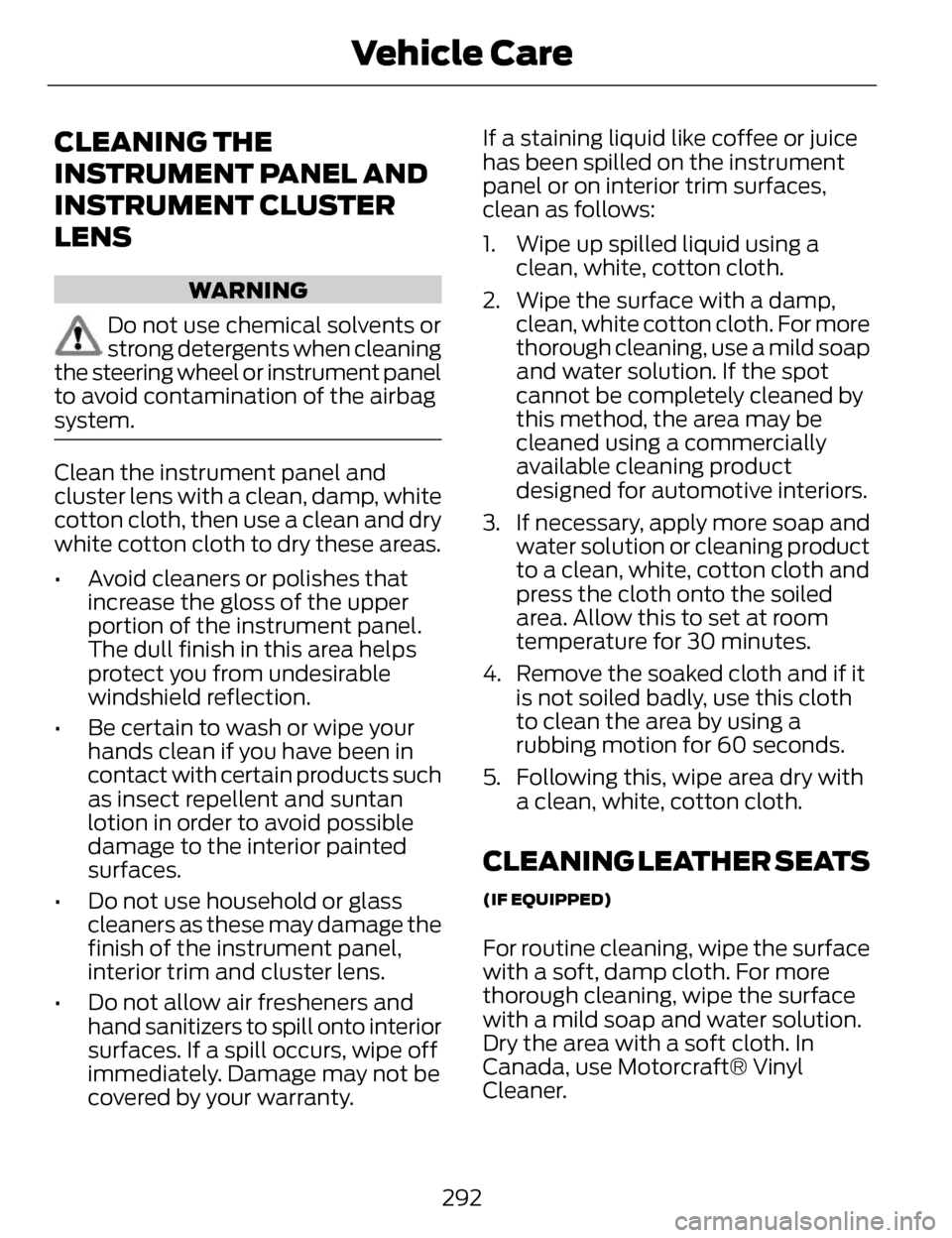
CLEANING THE
INSTRUMENT PANEL AND
INSTRUMENT CLUSTER
LENS
WARNING
Do not use chemical solvents or
strong detergents when cleaning
the steering wheel or instrument panel
to avoid contamination of the airbag
system.
Clean the instrument panel and
cluster lens with a clean, damp, white
cotton cloth, then use a clean and dry
white cotton cloth to dry these areas.
• Avoid cleaners or polishes that increase the gloss of the upper
portion of the instrument panel.
The dull finish in this area helps
protect you from undesirable
windshield reflection.
• Be certain to wash or wipe your hands clean if you have been in
contact with certain products such
as insect repellent and suntan
lotion in order to avoid possible
damage to the interior painted
surfaces.
• Do not use household or glass cleaners as these may damage the
finish of the instrument panel,
interior trim and cluster lens.
• Do not allow air fresheners and hand sanitizers to spill onto interior
surfaces. If a spill occurs, wipe off
immediately. Damage may not be
covered by y our warranty. If a staining liquid like coffee or juice
has been spilled on the instrument
panel or on interior trim surfaces,
clean as follows:
1. Wipe up spilled liquid using a
clean, white, cotton cloth.
2. Wipe the surface with a damp, clean, white cotton cloth. For more
thorough cleaning, use a mild soap
and water solution. If the spot
cannot be completely cleaned by
this method, the area may be
cleaned using a commercially
available cleaning product
designed for automotive interiors.
3. If necessary, apply more soap and water solution or cleaning product
to a clean, white, cotton cloth and
press the cloth onto the soiled
area. Allow this to set at room
temperature for 30 minutes.
4. Remove the soaked cloth and if it is not soiled badly, use this cloth
to clean the area by using a
rubbing motion for 60 seconds.
5. Following this, wipe area dry with a clean, white, cotton cloth.
CLEANING LEATHER SEATS
(IF EQUIPPED)
For routine cleaning, wipe the surface
with a soft, damp cloth. For more
thorough cleaning, wipe the surface
with a mild soap and water solution.
Dry the area with a soft cloth. In
Canada, use Motorcraft® Vinyl
Cleaner.
292
Vehicle Care
Page 296 of 468
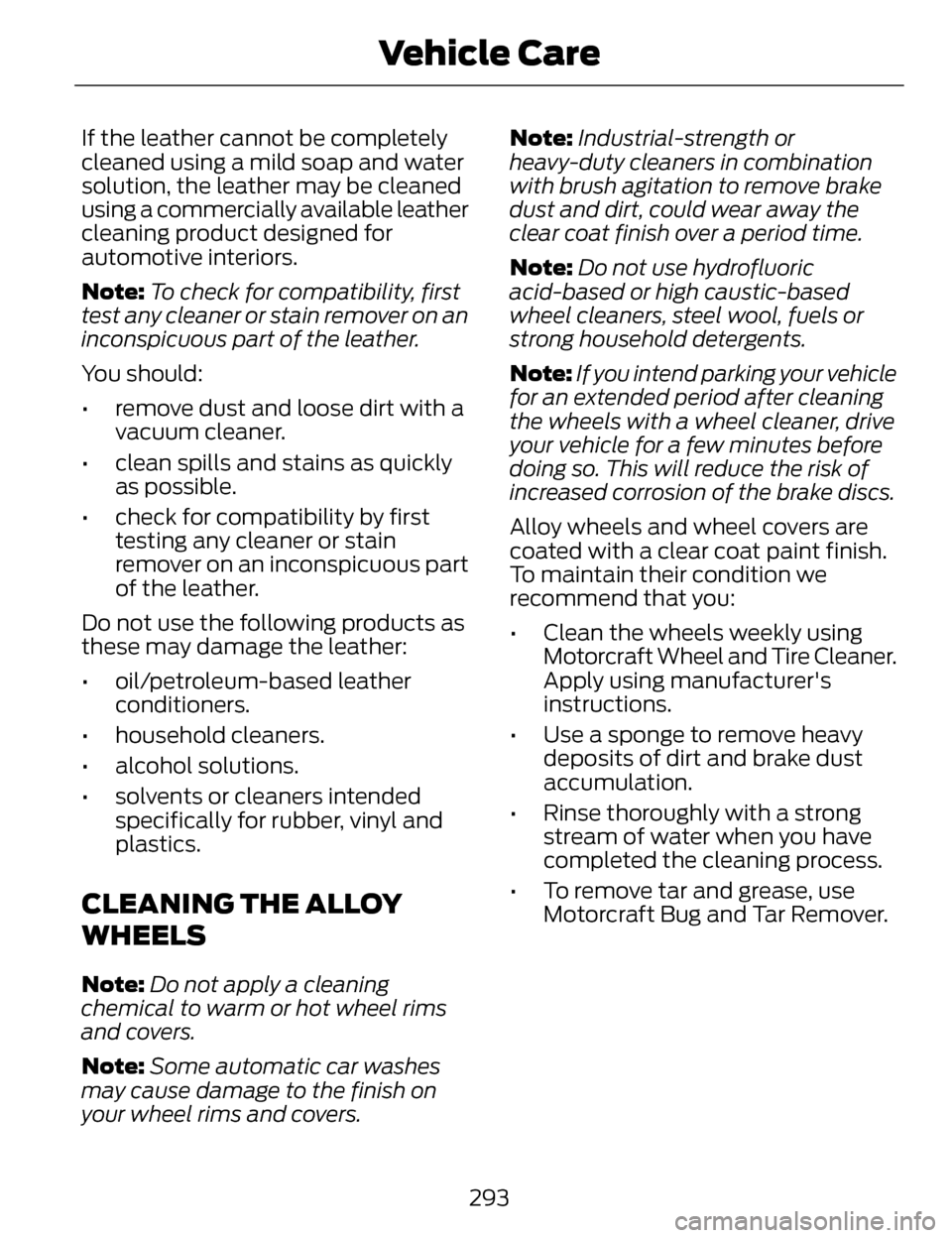
If the leather cannot be completely
cleaned using a mild soap and water
solution, the leather may be cleaned
using a commercially available leather
cleaning product designed for
automotive interiors.
Note:To check for compatibility, first
test any cleaner or stain remover on an
inconspicuous part of the leather.
You should:
• remove dust and loose dirt with a vacuum cleaner.
• clean spills and stains as quickly as possible.
• check for compatibility by first testing any cleaner or stain
remover on an inconspicuous part
of the leather.
Do not use the following products as
these may damage the leather:
• oil/petroleum-based leather conditioners.
• household cleaners.
• alcohol solutions.
• solvents or cleaners intended specifically for rubber, vinyl and
plastics.
CLEANING THE ALLOY
WHEELS
Note: Do not apply a cleaning
chemical to warm or hot wheel rims
and covers.
Note: Some automatic car washes
may cause damage to the finish on
your wheel rims and covers. Note:
Industrial-strength or
heavy-duty cleaners in combination
with brush agitation to remove brake
dust and dirt, could wear away the
clear coat finish over a period time.
Note: Do not use hydrofluoric
acid-based or high caustic-based
wheel cleaners, steel wool, fuels or
strong household detergents.
Note: If you intend parking your vehicle
for an extended period after cleaning
the wheels with a wheel cleaner, drive
your vehicle for a few minutes before
doing so. This will reduce the risk of
increased corrosion of the brake discs.
Alloy wheels and wheel covers are
coated with a clear coat paint finish.
To maintain their condition we
recommend that you:
• Clean the wheels weekly using Motorcraft Wheel and Tire Cleaner.
Apply using manufacturer's
instructions.
• Use a sponge to remove heavy deposits of dirt and brake dust
accumulation.
• Rinse thoroughly with a strong stream of water when you have
completed the cleaning process.
• To remove tar and grease, use Motorcraft Bug and Tar Remover.
293
Vehicle Care
Page 297 of 468
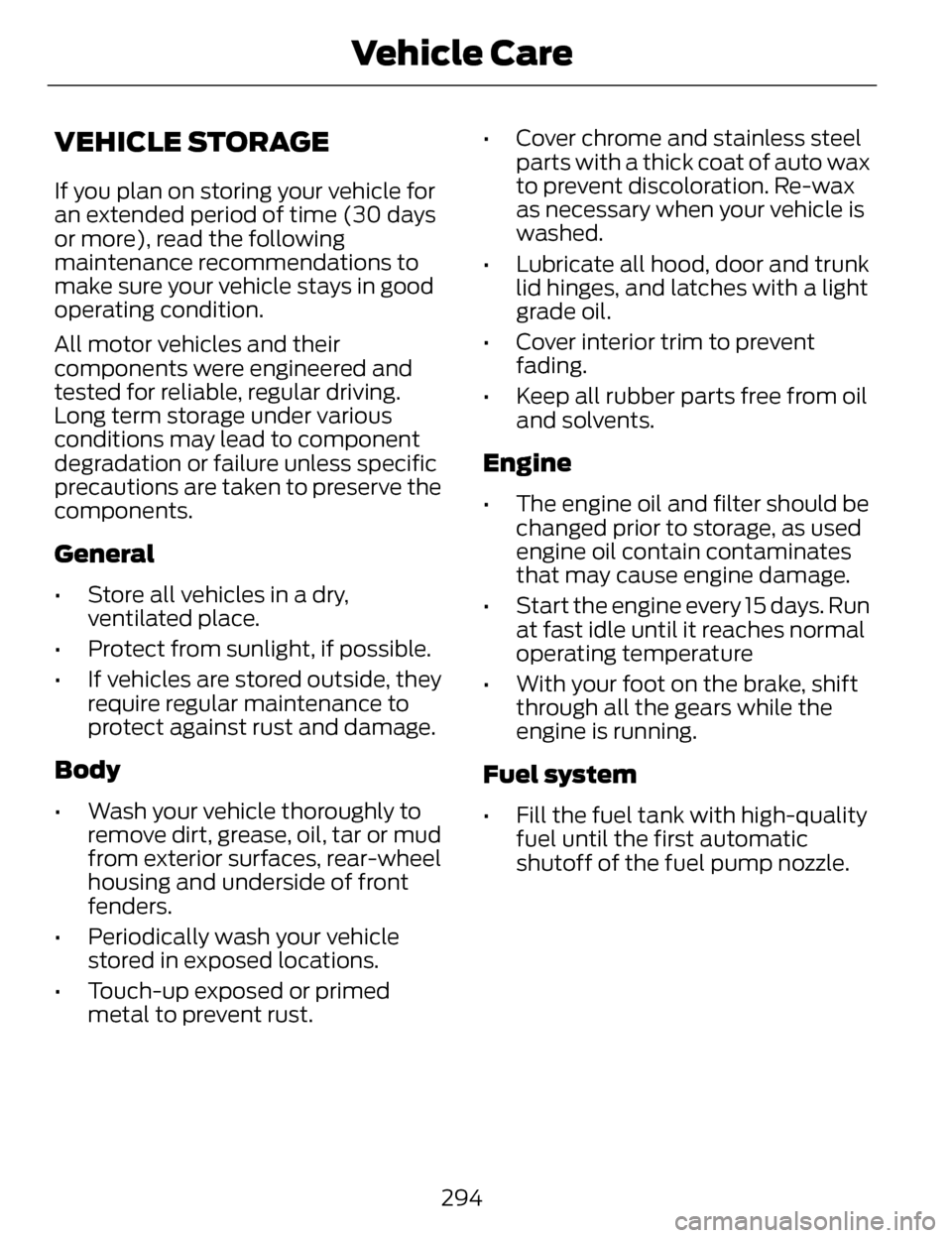
VEHICLE STORAGE
If you plan on storing your vehicle for
an extended period of time (30 days
or more), read the following
maintenance recommendations to
make sure your vehicle stays in good
operating condition.
All motor vehicles and their
components were engineered and
tested for reliable, regular driving.
Long term storage under various
conditions may lead to component
degradation or failure unless specific
precautions are taken to preserve the
components.
General
• Store all vehicles in a dry,ventilated place.
• Protect from sunlight, if possible.
• If vehicles are stored outside, they require regular maintenance to
protect against rust and damage.
Body
• Wash your vehicle thoroughly toremove dirt, grease, oil, tar or mud
from exterior surfaces, rear-wheel
housing and underside of front
fenders.
• Periodically wash your vehicle stored in exposed locations.
• Touch-up exposed or primed metal to prevent rust. • Cover chrome and stainless steel
parts with a thick coat of auto wax
to prevent discoloration. Re-wax
as necessary when your vehicle is
washed.
• Lubricate all hood, door and trunk lid hinges, and latches with a light
grade oil.
• Cover interior trim to prevent fading.
• Keep all rubber parts free from oil and solvents.
Engine
• The engine oil and filter should bechanged prior to storage, as used
engine oil contain contaminates
that may cause engine damage.
• Start the engine every 15 days. Run at fast idle until it reaches normal
operating temperature
• With your foot on the brake, shift through all the gears while the
engine is running.
Fuel system
• Fill the fuel tank with high-qualityfuel until the first automatic
shutoff of the fuel pump nozzle.
294
Vehicle Care
Page 298 of 468

Note:During extended periods of
vehicle storage (30 days or more), fuel
may deteriorate due to oxidation. Add
a quality gas stabilizer product to your
vehicle's fuel system whenever actual
or expected storage periods exceed 30
days. Follow the instructions on the
additive label. your vehicle should then
be operated at idle speed to circulate
the additive throughout the fuel
system.
Cooling system
• Protect against freezing temperatures.
• When removing your vehicle from storage, check coolant fluid level.
Confirm there are no cooling
system leaks, and fluid is at the
recommended level.
Battery
• Check and recharge as necessary.Keep connections clean.
• If storing your vehicle for more than 30 days without recharging
the battery, it may be advisable to
disconnect the battery cables to
ensure battery charge is
maintained for quick starting.
Note: If battery cables are
disconnected, it will be necessary to
reset memory features.
Brakes
• Make sure brakes and parking brake are fully released.
Tires
• Maintain recommended airpressure.
Miscellaneous
• Make sure all linkages, cables,levers and pins under your vehicle
are covered with grease to prevent
rust.
• Move vehicles at least 25 feet (8 meters) every 15 days to lubricate
working parts and prevent
corrosion.
Removing Vehicle From
Storage
When your vehicle is ready to come
out of storage, do the following:
• Wash your vehicle to remove anydirt or grease film build-up on
window surfaces.
• Check windshield wipers for any deterioration.
• Check under the hood for any foreign material that may have
collected during storage
(mice/squirrel nests).
• Check the exhaust for any foreign material that may have collected
during storage.
• Check tire pressures and set tire inflation per the Tire Label.
• Check brake pedal operation. Drive your vehicle 15 feet (4.5 meters)
back and forth to remove rust
build-up.
295
Vehicle Care
Page 299 of 468
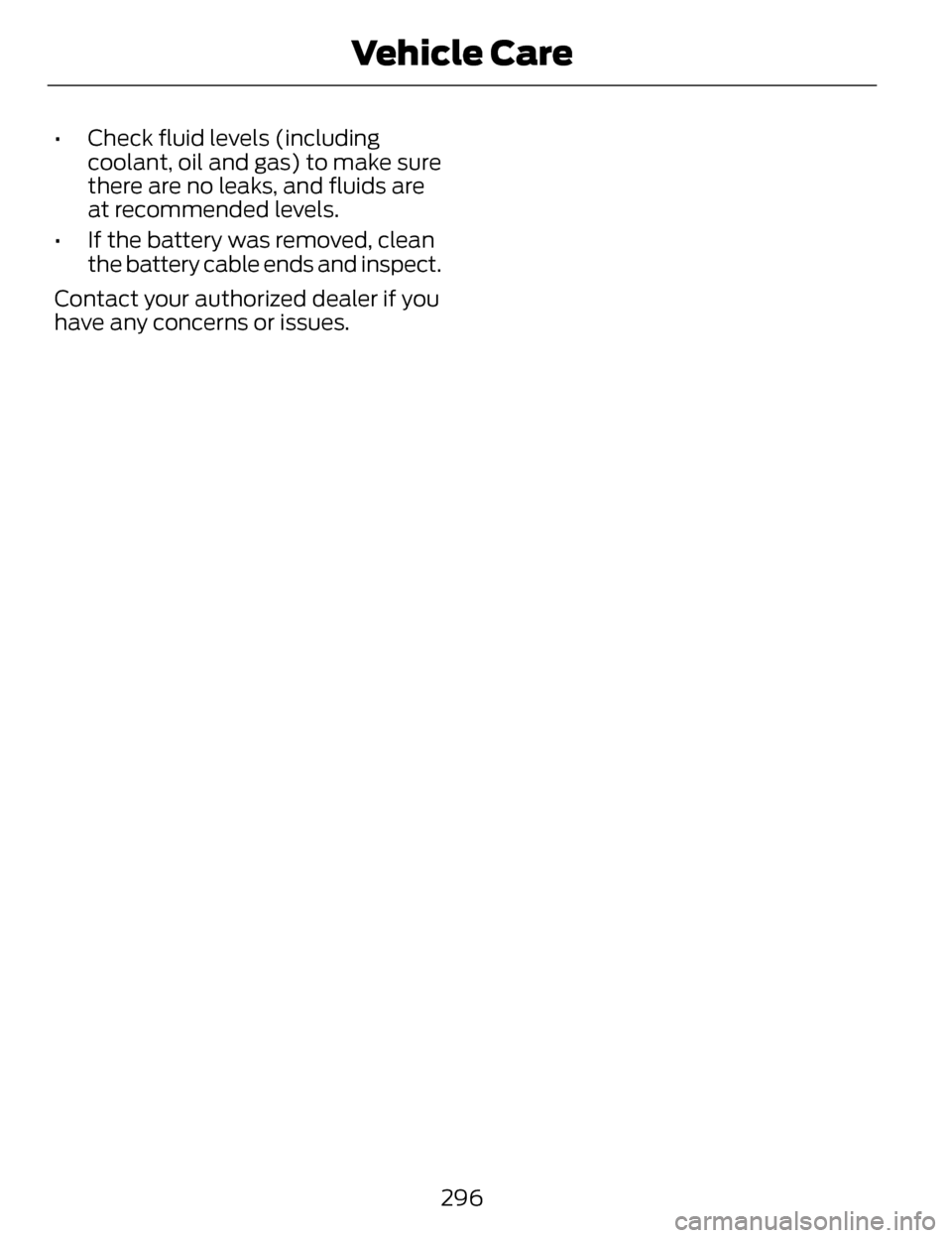
• Check fluid levels (includingcoolant, oil and gas) to make sure
there are no leaks, and fluids are
at recommended levels.
• If the battery was removed, clean the battery cable ends and inspect.
Contact your authorized dealer if you
have any concerns or issues.
296
Vehicle Care
Page 300 of 468
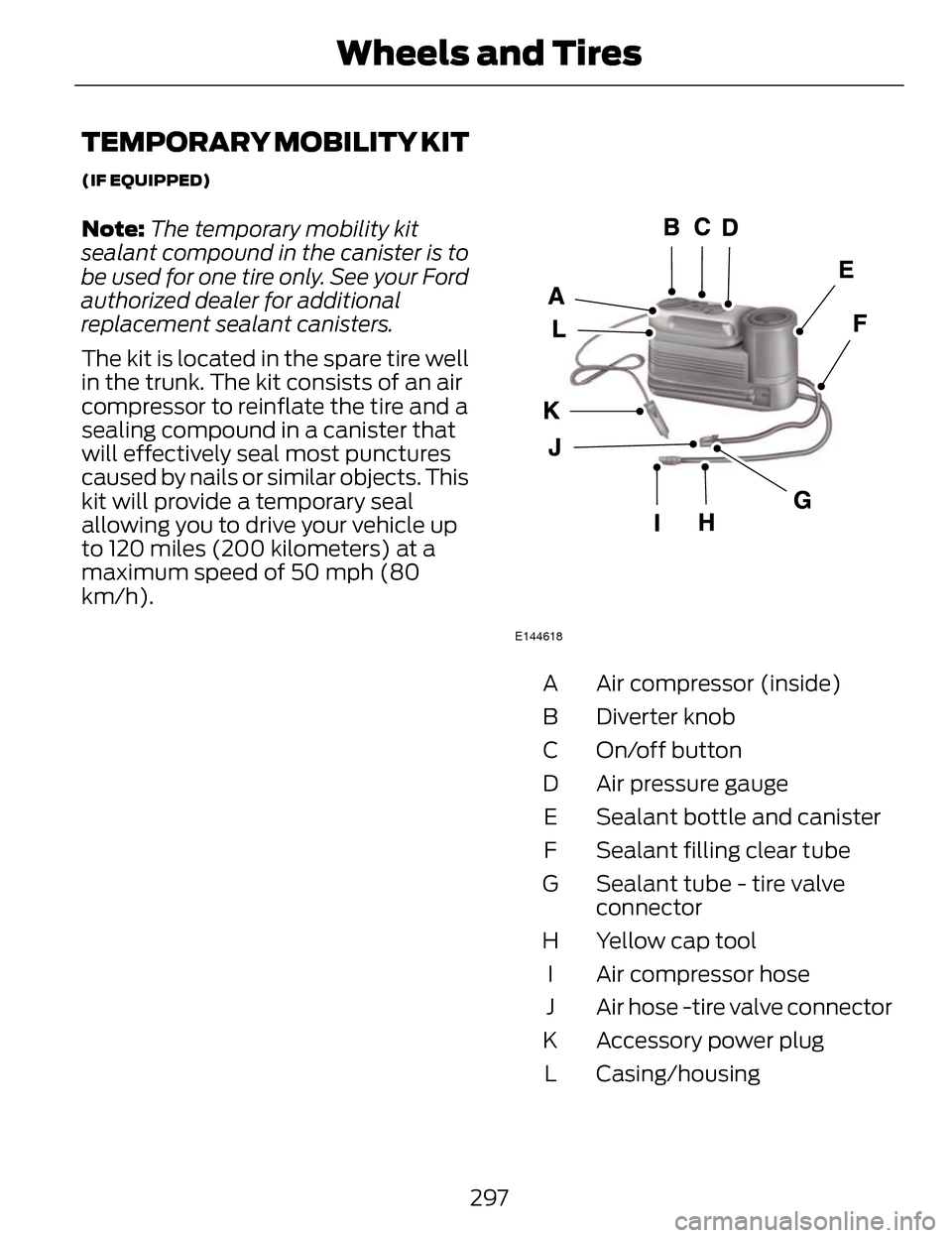
TEMPORARY MOBILITY KIT
(IF EQUIPPED)
Note:The temporary mobility kit
sealant compound in the canister is to
be used for one tire only. See your Ford
authorized dealer for additional
replacement sealant canisters.
The kit is located in the spare tire well
in the trunk. The kit consists of an air
compressor to reinflate the tire and a
sealing compound in a canister that
will effectively seal most punctures
caused by nails or similar objects. This
kit will provide a temporary seal
allowing you to drive your vehicle up
to 120 miles (200 kilometers) at a
maximum speed of 50 mph (80
km/h).
E144618
Air compressor (inside)
A
Diverter knob
B
On/off button
C
Air pressure gauge
D
Sealant bottle and canister
E
Sealant filling clear tube
F
Sealant tube - tire valve
connector
G
Yellow cap tool
H
Air compressor hose
I
Air hose -tire valve connector
J
Accessory power plug
K
Casing/housing
L
297
Wheels and Tires